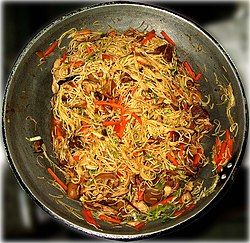Misua is cooked during important festivities, and eaten in mainland China as well in Cambodia, Malaysia, Indonesia, Singapore, Vietnam, Brunei, Thailand, Myanmar, and particularly in both Taiwan and the Philippines, which have the highest populations of Fujianese outside of mainland China.[citation needed]
Misua signifies long life in Chinese culture, and as such is a traditional birthday food. Because of this, it is often discouraged to chew or cut misua noodles.[3] It is usually served with ingredients such as eggs, tofu, bell peppers,[3] oysters, pig's large intestine,[2] shiitake mushroom, beef, shallots, or scallions, roasted nuts or fried fish.
In Taiwan, there are two forms of misua. The first is plain, while the second has been steamed at high heat, caramelizing it to a light brown colour. For birthdays, plain misua is usually served plain with pork hocks (猪腳麵線) in stewed broth as a Taiwanese birthday tradition. Brown misua can be cooked for prolonged periods without disintegrating in the cooking broth and is used in oyster vermicelli (蚵仔麵線), a dish popular in Taiwan.[citation needed]
